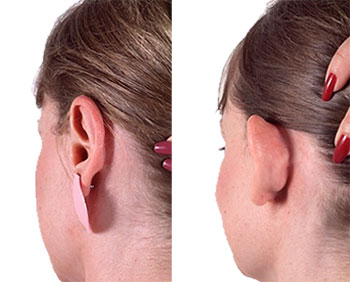
Prominent Ear Surgery
The structure and maturation of the outer ear begins to become evident from the first days of life. The external ear's upturned position at a wide angle with the head receives different names in various languages, such as prominent ear, sail ear, cup ear. Although the discrete ear structure in childhood is attributed to the child's posture in the prenatal period, this is not true; this structure is determined mostly by genetic characteristics.

Although correction of Protruding Ear deformity can be done at any age, the period before the beginning of primary school age should be preferred. The reason for this is that during primary education, children make jokes and call themselves protruding ears, alienating the child from school and causing failure. Correcting the prominent ear disorder not only corrects an unpleasant appearance but also improves the child's psychology.
The disorder can be unilateral or bilateral. Both ears can be operated on at the same time.
What should be taken into consideration in prominent ear surgery?

There are various methods for correcting prominent ears. Although there are surgeries performed in front of the ear, surgeries performed behind the ear are more common. The given ear shape is protected by internal and external stitches, and it is difficult to see the surgical scar in surgery methods that use the back of the ear. Although general anesthesia is required for surgery in childhood, it can be easily performed with local (regional) anesthesia in adulthood, so the patient does not need to be hospitalized.
It is beneficial to use a headband (bandana) for about a week after the surgery, both to maintain the new position and to ensure comfort while lying down. Depending on the work done, it is possible to start work after a few days.
The outer ear has many congenital disorders other than the deformity of the prominent ear. These are many forms of disorders that can occur in various structures, such as the ear being small, having appendages, or not developing at all. These disorders are operated on in various stages depending on the size of the problem. In cases where the ear has not developed at all, it may be necessary to use rib cartilage or ready-made prostheses to create the ear skeleton.

What causes prominent ear problem?
The prominent ear problem is a structural problem. In other words, it starts from birth. It is a structural disorder seen in the first years of infancy and childhood and can be corrected by surgery.
When should prominent ear correction surgery be performed?

We often prefer to have prominent ear correction surgery done before starting primary school. In primary school, children's friends calling them "prominent ears" alienates them from school. Around 5-6 years of age is the ideal age to correct this; But many people exceed these ages, they apply to us with this problem at high school and university ages. At these ages, it is possible to correct the condition by anesthetizing it only with a needle, without giving general anesthesia.
Will there be any scars after prominent ear surgery?
Since this procedure is performed behind the ear, the scars are not visible when viewed from the front or from the side, as the scars remain behind the ear. Here, the ear is given the desired shape and the ear is slightly tilted back, reducing its conspicuousness.
Will the ear return to its former state after prominent ear correction surgery?

It is not possible for the ear to regain its previous shape, to open the ears again, to become prominent ears. Because during this surgery, permanent stitches are placed on the cartilages. However, if the ear is subjected to a major trauma, the ear is pulled, or something undesirable develops, there may be a slight deterioration in the structure after the surgery; However, if left untouched, this is a surgical method that remains successful for years.






